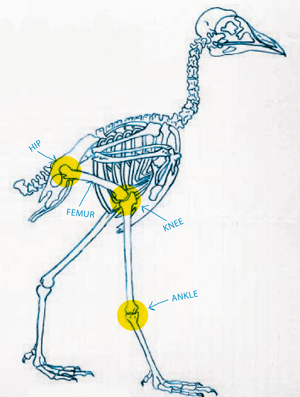Three: Without a Leg to Stand On
Bird Legs Differ from Dinosaur Legs
Birds are vastly different from dinosaurs, even in the way they walk. How could one come from the other?
“Birds are the modern version of dinosaurs,” declare many evolutionists who believe theropod dinosaurs evolved into birds.1 Artists even go so far as to depict these reptiles with feathers and other avian features.2 But not all evolutionists accept the dogma. In a recent Journal of Morphology paper, Devon Quick and John Ruben of Oregon State University exposed a major flaw in the dinosaur-to-bird model—and simultaneously revealed a unique feature of bird biology.3
The scientists examined the unusual way that birds use their femur (thigh bone) when walking. Unlike most other creatures, birds do not move their femurs significantly. Instead, birds use their lower legs. But their odd “knee running” motion isn’t just a funny quirk. It’s actually crucial to their ability to breathe rapidly. The femur bones and thigh muscles support the bird’s air-sac lung as it breathes, preventing the lungs from collapsing.

The Bird Walk—Birds have a distinct, almost comical, way of walking (from the knee down). Scientists now understand the reason behind this unusual walk. The bird’s upper leg bone (the femur) must remain firmly in place to support their unique air-sac lung. Why don’t dinosaurs have lungs or legs similar to birds? The answer should be pretty obvious. Picture courtesy of Oregon State University.
“This is fundamental to bird physiology,” Quick said. “It’s really strange that no one realized this before.”
Dinosaur fossils show no evidence of fixed femurs, the researchers determined. “Theropod dinosaurs had a moving femur and therefore could not have had a lung that worked like that in birds,” Ruben explained. “That undercuts a critical piece of supporting evidence for the dinosaur–bird link.” The lung structure and physiology of dinosaurs was likely much closer to crocodilian creatures than to birds.
David Menton, a former Washington University anatomist who has researched the dinosaur-to-bird idea, commented, “It appears that both feathers and the avian mode of breathing are unique to birds.”
Perhaps the dinosaur–bird connection, now rejected by creationists and some evolutionists, will one day fall out of favor entirely. But Ruben noted, “There’s a lot of museum politics involved in this, a lot of careers committed to a particular point of view even if new scientific evidence raises questions.”
At the very least, we now know of another ingenious anatomical feature that the Creator gave birds from the very beginning so they could achieve the miracle of flight.
Answers Magazine
January – March 2010
Fossils are filled with mystery. They are commonly used to attack the biblical worldview, but in reality the Bible gives us the keys to help us solve these mysteries. How could recently discovered dinosaur tissue have survived until today? Why is the first fossil layer filled with such an astonishing variety of life (“the Cambrian Explosion”)? Read this issue to understand these and other mysteries of our world!
Browse Issue SubscribeFootnotes
Recommended Resources

Answers in Genesis is an apologetics ministry, dedicated to helping Christians defend their faith and proclaim the good news of Jesus Christ.
- Customer Service 800.778.3390
- © 2024 Answers in Genesis





